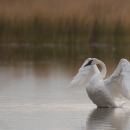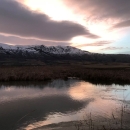About Us
Camas National Wildlife Refuge was established in 1937 to manage habitat to benefit nesting waterfowl, and to provide resting and feeding habitat for spring and fall migration of ducks, geese, and other waterfowl. Today, the Refuge provides excellent opportunities to view and photograph wildlife throughout the year. The refuge is named for Camas Creek which winds its way through the refuge, feeding many wetlands and providing vital habitat for wildlife and plants.
The established purpose for Camas National Wildlife Refuge is derived from Executive Order 7720….”as a refuge and breeding ground for migratory birds and other wildlife”.
The goals and purposes Camas NWR align with those of the Refuge system:
- Conserve a diversity of fish, wildlife and plants and their habitats, including species that are endangered or threatened with becoming endangered.
- Develop and maintain a network of habitats for migratory birds that is strategically distributed and carefully managed to meet important life cycle needs of those species.
- Conserve those ecosystems, plant communities, wetlands of national or international significance, and landscapes that are unique, rare, declining, or underrepresented in existing protection efforts.
Our Mission
The mission of the National Wildlife Refuge System is to administer a national network of lands and waters for the conservation, management and, where appropriate, restoration of the fish, wildlife and plant resources and their habitats within the United States for the benefit of present and future generations of Americans.
Our History
A Tradition of Hunting and Gathering
The ancestral lands of both the Shoshone and Bannock tribes occupied vast regions including the area that is the refuge today. The area of the refuge is known as Sohodai (cottonwood hole), and remains important to the Shoshone-Bannock Tribes. Just as wildlife must move throughout the land in different seasons to survive, people subsisting as hunters and gatherers traveled during the spring and summer seasons, collecting foods for use during the winter months. They hunted wild game, fished the region's abundant and bountiful streams and rivers (primarily for salmon), and collected native plants and roots such as the camas bulb.
From Ranch to Refuge
In the late 1800s, a large portion of the present day refuge was part of a large livestock ranch known as Idaho Livestock Lands, Inc. Other smaller parcels were homesteaded by families who later sold these tract to the government to become part of Camas NWR.
About the same time, a wagon and stage road was established between the railhead at Corrine, Utah, across the Snake River Plain to Monida Pass on the Idaho-Montana border, and on to the gold fields in Montana. A short segment of this wagon and stage road passed through what is now Camas Refuge. One of the many overnight stage stops was located at Sandhole Lake in the southeast corner of the refuge. The refuge was established in 1937 to manage habitat to benefit nesting waterfowl, and to provide resting and feeding habitat for spring and fall migration of ducks, geese, and other waterfowl.
In the 1930s and early 1940s, crews from the Works Progress Administration (WPA) constructed the refuge headquarters buildings, water control structures and bridges. Before establishment of the refuge, one part of the marshland was used to raise muskrats for the fur industry; its present name, Rat Farm Pond, hints of its past.
Key Dates
October 8, 1937 – The refuge was established by President Franklin D. Roosevelt as refuge and breeding ground for migratory birds and other wildlife.
On July 25, 1940 – The name of the refuge was changed from Camas Migratory Waterfowl Refuge to Camas National Wildlife Refuge under Presidential Proclamation 2416, “Changing the Names of Certain Federal Wildlife Refuge.”
In 1978 Camas NWR becomes part of the newly formed Southeast Idaho Refuge Complex.
Other Facilities in this Complex
Camas National Wildlife Refuge is part of the Southeast Idaho National Wildlife Refuge Complex.
The Southeast Idaho National Wildlife Refuge Complex administers six refuges within the National Wildlife Refuge System: Bear Lake, Camas, Deer Flat, Grays Lake, and Minidoka National Wildlife Refuges, and Oxford Slough Waterfowl Production Area. The Complex office is located in Chubbuck, Idaho.



